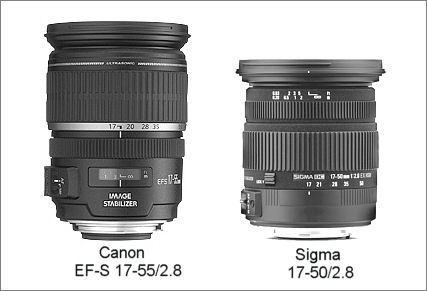

Canon EF-S 17-55/2.8 IS USM and Sigma 17-50/2.8 EX DC OS HSM Review

Distortion
Both the Canon EF-S 17-55/2.8 IS USM and Sigma 17-50/2.8 EX DC OS HSM show fairly low distortion. A rough estimate of distortion is given in the table below. These numbers are based on my own measurements and correspond to the SIMA definition 5.20 for TV image distortion (based on the difference between the edge and center height of a box which fills the frame). Both lenses appeared to show simple 3rd order distortion (i.e. pincushion and barrel distortion rather than "complex" distortion).
| Canon | Sigma | |
| 50mm | 1.6% (pincushion) | 1% (pincushion) |
| 35mm | 1.7% (pincushion) | 0.8% (pincushion) |
| 17mm | 0.6% (barrel) | 1% (barrel) |

As a point of comparison, using the same technique on the EF-S 17-85/3.5-5.6IS USM. at 17mm I measured 3.2% barrel distortion.
Vignetting
As would expected for fairly fast lenses, both the Canon EF-S 17-55/2.8 IS USM and the Sigma 17-50/2.8 EX DC OS HSM show some vignetting throughout the focal length range when used wide open at f/2.8. Overall I'd say that the Canon EF-S 17-55/2.8 shows slightly more vignetting then the Sigma 17-55/2.8, but both lenses are pretty good and the majority of the visible vignetting goes away if either lens is stopped down by a stop, especially at longer focal lengths. In both cases vignetting is most noticeable at 17mm wide zoom setting.

Canon's DPP program (provided free with all Canon DSLRs) will automatically correct vignetting when you shoot in RAW with the Canon EF-S 17-55/2.8 IS but will not correct images shot with the Sigma 17-50 (or any other non-Canon lens). Some Canon DSLRs can also perform in-camera vignetting correction when used with Canon lenses. However other RAW converters and image editors (e.g. Photoshop) may be able to apply vignetting correction to images shot with either lens.
Color Balance
I'm not overly concerned about slight differences in color castes between lenses since when shooting digital they are easily corrected post exposure. Nevertheless I did notice that, using the same camera settings, the Sigma 17-50/2.8 EX DC OS HSM consistently produced slightly warmer toned images than the Canon EF-S 17-55/2.8 IS USM

Macro
While neither of these lenses makes any claim to be a macro lens, the Sigma provided slightly higher maximum magnification despite the slightly shorter maximum focal length. This seems to be due to the fact that it can focus slightly closer than the Canon lens.
| Canon 17-55/2.8 | Sigma 17-50/2.8 | |
| Closest Focusing | 13" | 11" |
| Max. Magnification | 0.17x (at 55mm) | 0.20x (at 50mm) |
Image Stabilization
Image stabilization is hard to quantify, but in a series of hand held tests at slow shutter speeds, the IS systems of both the Canon EF-S 17-55/2.8 IS USM and Sigma 17-50/2.8 EX DC OS HSM were effective to the extent of allowing shooting a around 2.5 to 3 stops slower than without IS and still retaining the same probability of getting a sharp image. If I had to give an edge to either system I'd say that the Canon lens perhaps has a slight advantage, but the difference is small. Both lenses claim "up to 4 stops" but neither Canon nor Sigma cite the test criteria used to generate that number. It's certainly possible that if luck was on your side you might get some sharp images with IS on and a 4 stop slower shutter speed, but it's certainly not something you should depend on. 2 stops is pretty safe, 3 stops isn't bad - but I'd still take 2 or 3 shots and pick the sharpest!
NEXT: Image sharpness and Chromatic Aberration
